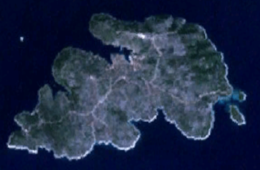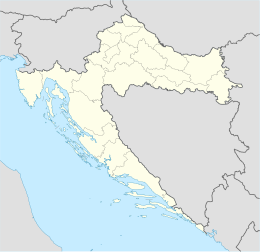 Satellite image of Drvenik Veli Satellite image of Drvenik Veli | |
 | |
| Geography | |
|---|---|
| Location | Adriatic Sea |
| Coordinates | 43°26′39″N 16°08′44″E / 43.444226°N 16.145439°E / 43.444226; 16.145439 |
| Area | 12.07 km (4.66 sq mi) |
| Highest elevation | 178 m (584 ft) |
| Administration | |
| County | Split-Dalmatia |
| Demographics | |
| Population | 150 (2011) |
| Pop. density | 12.42/km (32.17/sq mi) |
Drvenik Veli is a Croatian island in the Adriatic Sea. It is situated in the middle of the Dalmatian archipelago, northwest of Šolta, 1.8 kilometres (1.1 miles) from the mainland. Its area is 12.07 square kilometres (4.66 sq mi). The highest peak is 178 metres high. The only settlement on the island is the near-eponymous village of Drvenik Veliki (pronounced [dr̩v̞ɛ̌niːk v̞ɛ̂likiː]) with a population of 150 (2011 census).
The island was first inhabited in the 15th or 16th century. The main industries on the island are agriculture, fishing and tourism. The coast of the island is mainly rocky, but also has a few famous sand and pebble beaches like Krknjaši and Kokošinje.
Etymology
Since ancient times, the island has been known by its Romanized name, Zirona. The name Zirona likely originated from the Illyrian root "gųer" meaning "forest", possibly because of the island's once dense woodlands. In Croatian documents from the 13th century, the island is mentioned as Girona, Gerona or Giruna. Some suggest that the name Girona might have Greek origins, derived from the noun "gyrona" meaning "rounded object", a notion supported by the island's somewhat rounded morphology. The Croatian name Drvenik ("veli" means "large" in Croatian) finds its origin in the Croatian word "drvo", meaning "wood", establishing a link either to its Illyrian roots, according to some, or to the town of Drvenik near Makarska, from which a significant portion of its population migrated in the 17th century.
Gallery

References
- (in Croatian) Basic facts about Drvenik Archived 2007-02-11 at the Wayback Machine
- Duplančić Leder, Tea; Ujević, Tin; Čala, Mendi (June 2004). "Coastline lengths and areas of islands in the Croatian part of the Adriatic Sea determined from the topographic maps at the scale of 1 : 25 000" (PDF). Geoadria. 9 (1). Zadar: 5–32. doi:10.15291/geoadria.127. Retrieved 2019-12-26.
- ^ Ostroški, Ljiljana, ed. (December 2015). Statistički ljetopis Republike Hrvatske 2015 [Statistical Yearbook of the Republic of Croatia 2015] (PDF). Statistical Yearbook of the Republic of Croatia (in Croatian and English). Vol. 47. Zagreb: Croatian Bureau of Statistics. p. 47. ISSN 1333-3305. Retrieved 27 December 2015.
- "Population by Age and Sex, by Settlements, 2011 Census: Drvenik Veli". Census of Population, Households and Dwellings 2011. Zagreb: Croatian Bureau of Statistics. December 2012.
- ^ (in Croatian) "Drvenik veli". General Encyclopedia of the Yugoslav Lexicographical Institute (in Croatian). Vol. 2. Zagreb: Yugoslav Lexicographical Institute. 1977.
- Andreis 1998, p. 228.
- ^ (in Croatian) First Croatian online peljar
- ^ Marasović-Alujević, Marina (2019-12-11). "Romanstvo i slavenstvo u toponimiji otoka zapadnoga dijela splitskoga akvatorija – prilog etimološkomu istraživanju". Folia onomastica Croatica (in Croatian) (28): 149. doi:10.21857/y7v64t5v6y. ISSN 1330-0695.
Sources
- Andreis, Mladen (October 1998). "Povijesna demografija Velog Drvenika, Malog Drvenika i Vinišća do god. 1900" (PDF). Radovi Zavoda za povijesne znanosti HAZU u Zadru (in Croatian) (40): 227–301. Retrieved 14 September 2018.
External links
- (in Croatian) Web site dedicated to Drvenik veliki Archived 2012-11-11 at the Wayback Machine